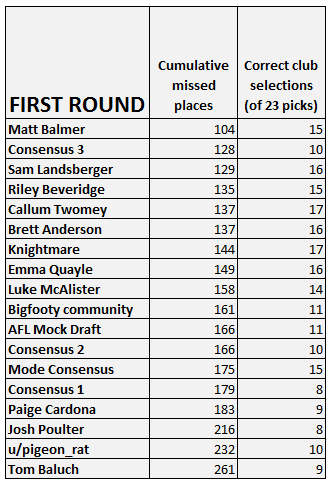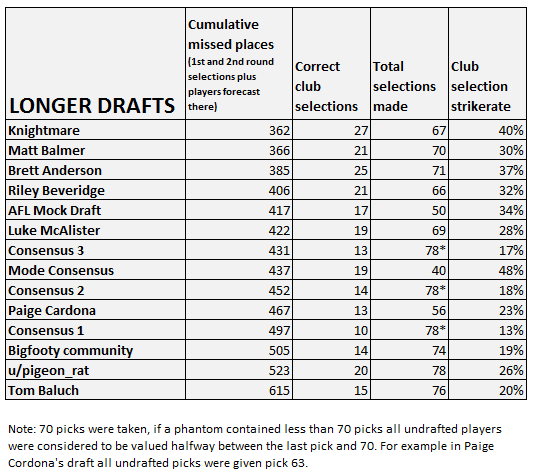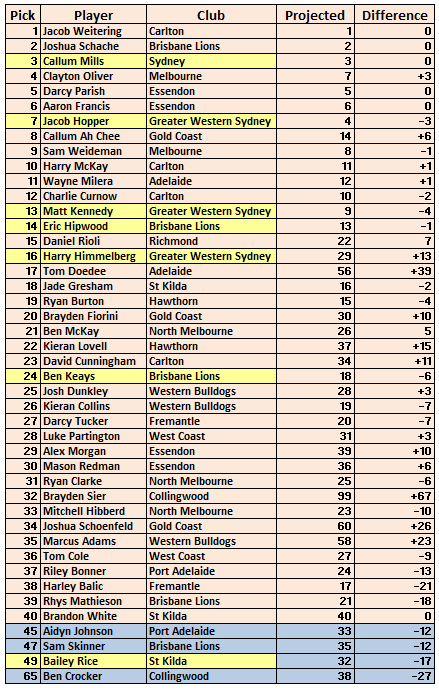The glorious subdued chaos of the AFL National Draft has come and gone, so let’s look at how the phantom drafts did.
And the winner is
To start with, let’s take a look at how the different phantom drafts did. We’ve looked firstly at the first round in isolation:

A big congratulations must be extended to Matt Balmer, a first-year journalism student who has managed to get closest to the pin in his phantom draft this year, beating the long established draft gurus at each of the major football publications in terms of cumulative positions away from the pin. The cumulative effect of his being close to the mark with academy bid predictions (eg Hopper and Himmelberg) and also of getting most other players near to the mark put him in front here.
In terms of getting players going to the right clubs, however, Knightmare and Cal Twomey took the honours with 17 correct predictions out of 23. We can assume that Twomey would have had 18 and the outright lead, but his 30-pick phantom draft didn’t have Himmelberg going top 30.
We then looked at the drafts that went longer and compared them on their accuracy in the first two rounds. For this measure, the “cumulative missed places” measure encompasses the first 40 selections, plus players who projected by consensus to be in that range but who slid (ie Johnson, Skinner, Rice and Crocker). Exact club positions covers every selection published by a mock drafter:

Matt Balmer again performed extremely well but over the full distance, Bigfooty’s indefatigable phantom draft king Knightmare just pips him (in something close to an effective tie).
Where Knightmare shone was in getting players to their correct club, nailing a full 40% of his selections. Our shorter Mode draft got 19 of 40, a rate of 48%, but this is a less impressive achievement than getting so many later-drafted players right.
As with last year, phantom drafts even a couple of days early suffered in accuracy. Paige Cardona’s draft was published on the 18th, 6 days before the draft, and Josh Poulter and u/pigeonrat’s were even earlier. A late subtle shift in early team selections (such as Oliver to Melbourne, or McCartin to St Kilda last year) can have a cascading effect and move a lot of other picks around. Similarly, our consensus got closer as the source drafts got closer to the day itself.
How our drafts did
In terms of our two phantom consensus methods, the mode selection versus average selection, both performed as expected. Mode (ie, each pick allotted the most frequently selected player) was much better at getting players to their correct club.
The consensus based on averages of selection positions got a lot closer to the overall draft order (measured in terms of cumulative missed places), and in the first round was ahead of all except Matt Balmer.
This does suggest some emergent wisdom can be gleaned from the “average of positions” method that doesn’t necessarily come from any one individual expert.
The Phantom Consensus
Now, here’s a comparison of the first 40 picks to the phantom consensus draft, which we assembled as the average of our expert phantom drafters:

A mixed bag, really. Some picks were very close (Brandon White at 40 was an exact match) and the top players were mostly pretty close.
Risers and sliders
Compared to the expert consensus, Brayden Sier was the biggest riser. Summing all the drafts we had him ranked somewhere around 99, a meaninglessly low, “won’t get drafted” position, so his pick 32 was a full 67 places higher. Tom Doedee’s maximum projection was 40 and was often left undrafted, so going at 17 put him 39 places ahead of expectations.
Harley Balic, often predicted to go in the late first round, slid all the way to Fremantle at 38 (down 21 from a projected position of 17) and then Brisbane with pick 39 secured Rhys Mathieson, 18 picks past his consensus pick of 21.
In terms of clubs who “won” or “lost”, nobody can really say of course. However, we can note that compared to the expert consensus, Brisbane (Mathieson and Skinner), North Melbourne (Clarke and Hibberd), Fremantle (Tucker and Balic) and Port Adelaide (Bonner and Johnson) each secured two players who slid a good distance, mostly by over 10 picks past their consensus selection.
Essendon, by contrast, in the second round reached down the rankings for Alex Morgan and Mason Redman, but will not care at all having gotten Parish and Francis early.
Really though, Geelong wins, having secured this bloke.
The misses
Tom Doedee going to Adelaide was a much commented shock (we at HPN having watched the phantoms were as shocked as anyone) but there were a few other wildcards last night.
The highest selected player nobody mentioned at all was Mackenzie Willis (Gold Coast, pick 52), then it was Samuel Collins (Fremantle, 55). Also notable was Brayden Sier taken at 32 by Collingwood, a player only Brett Anderson mentioned at all and only in his final day publication. Liam Hullett (Melbourne, 46) was in an early cut of Anderson’s work but otherwise fell by the phantom wayside by draft day.
Sier’s selection is a repeat of last year where Brett Anderson was also the only one to select Patrick McKenna, who bolted to GWS at 23.
Conversely several players went undrafted from our “most frequent selection” or Mode top 40 (Callum Moore, Nick O’Kearney, William Snelling, and Jesse Glass-McCasker). We would expect such players to be picked up in the rookie draft on Friday.
Dunkley declined
We were pretty surprised that Josh Dunkley was not matched by the Swans at 25. Sydney had the points to do so without deficit, so perhaps they did indeed make the call, as predicted by several journalists, to let him go as part of a side-deal to let him stay in Victoria (or even as a quid pro quo for getting Talia for free, not that we’re suggesting that such shenanigans ever occur).
As the Swans tell it, they wanted good accurate kicks and thus preferred to run with live picks at 51 and 56. That’s certainly plausible enough to head off any allegations of impropriety, and it’s where they once secured Nick Malceski, but it does raise the question as to why get him to nominate at all. The more ruthless approach would have been to draft him and then trade him home next year, presumably for a pick better than 51.
Academy generosity – mostly
Most of the Academy selections slid further than generally anticipated. Hopper, Kennedy, Hipwood and Keays all went later than projected. Mills may have been the best player in an open draft (if Hopper wasn’t) and went at three. Himmelberg is an anomaly having gone early, but Adelaide still used their last available pick with seemingly a clear left-field plan that also involved taking Tom Doedee out of nowhere.
In year one of the parallel draft pool era, it seems that we were quite wrong in our speculation about clubs playing some ruthless game theory with northern states who had showed their hand. We can’t say whether this was caution, fear of the AFL, not wanting to appear to slight their eventual selections, or just gentlemanly camaraderie in the cloistered world of AFL recruiters. But the trend was clear.
Who got Geelong’s picks?
Finally, to the sleepers of this year’s draft. We said last post that we’d look at the Cats and it turns out that Brett Anderson at SEN correctly predicted Ryan Gardner and Sam Menegola and was the only one to get two right (Riley Beveridge also had Menegola at Geelong). Nobody even had Matthew Heyball on their list at all and only Tom Baluch had Wylie Buzza (to Fremantle, at pick 26), so it’s fair to say Geelong blindsided everyone with their last couple of selections.

Reblogged this on mattbalmermedia and commented:
Matt Balmer placed first with the closest first round Phantom Draft prediction.